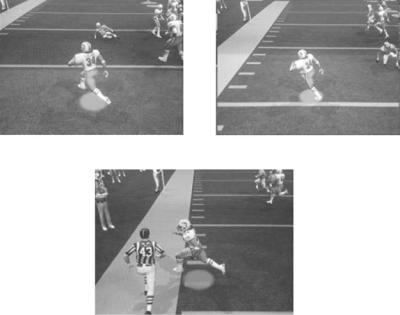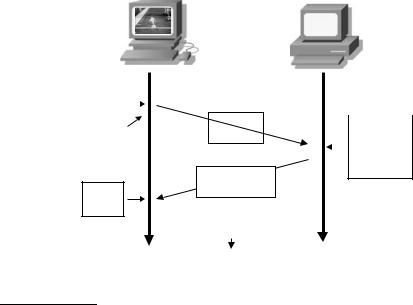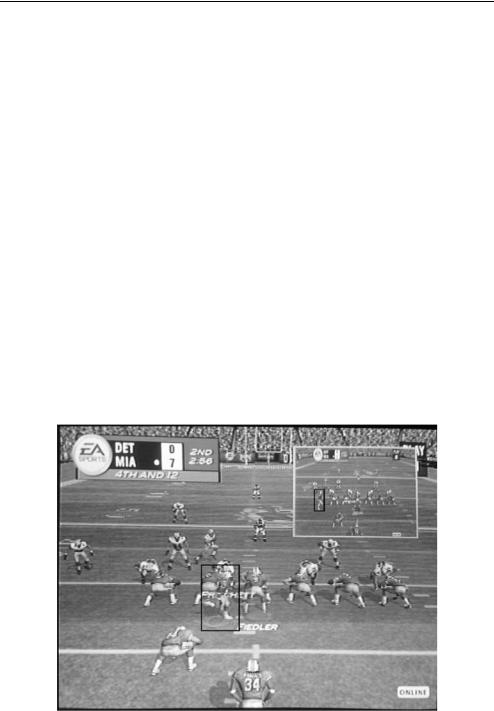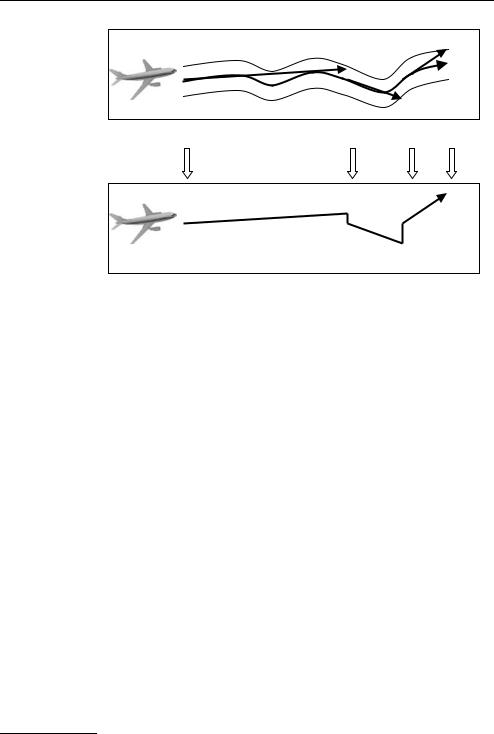
Название-Сеть в Играх 2006год_Язык-Eng
.pdf
84 Networking and Online Games: Understanding and Engineering Multiplayer Internet Games
(b)It will be quite some time before broadband is globally adopted by all online game players.
(c)There is an increasing number of mobile, wide-area wireless environments that cannot benefit from the fixed infrastructure of broadband to the home.
(d)Despite technology improvements, a certain amount of network delay will always remain because of the speed of light in fibre. For example, coast-to-coast delays across the United States of America cannot be less than about 25 milliseconds, not counting any additional delays from buffering. Intercontinental times will be even higher.
Most games today basically run on a client–server architecture with a single, authoritative server that handles the game logic. The clients collect input from the user and send it to the server. The server computes game state, sending the revised game state information back to the client. The client then renders the new game state to the player, and the process repeats. In some cases, the server can also act like a client, allowing a player to use the same machine as the server. In this case, the player offers to ‘host’ a game. That player’s computer then acts like a server for all players, as well as a client for the current player. This is still fundamentally a client–server architecture, even though it may look like client–client (or peer-to-peer) on the surface, in that all machines are being used as game clients.
To illustrate the effects of latency on this basic architecture, consider the client to be where the user input is taking place. In the basic client–server model, the client sends a message to the server when user input is received. The server processes (and validates) the input and sends the results back to the waiting client to render on the local display. Thus, the players’ actions are lagged by the round-trip latency between client and server. When the client acts in this manner, it is often called a ‘Dumb’ client since it only acts on commands from the server, and is depicted in Figure 6.1.
|
|
|
|
|
|
|
|
|
|
|
|
User |
|
|
|
|
|
|
|
|
|
|
|
input |
|
|
|
|
|
|
|
|
|
|
|
|
|
|
|
Message: |
|
|
|
|
|
|
|
|
|
|
|
|
|
|
|
|
|
Process |
|
|
|
|
|
|
user input |
|
|
|
|
|
|
|
|
|
|
|
|
|
|
|
|
and |
|
|
|
|
|
|
|
|
|
|
|
|
|
|
|
|
|
|
|
|
|
|
|
|
|
|
|
|
|
|
|
|
|
|
|
|
validate |
|
|
|
|
|
|
|
|
|
|
|
input |
|
|
|
|
|
Message: |
|
|
|
|
||
|
|
|
|
|
|
|
|
|
|
||
|
|
|
|
|
|
|
|||||
Render |
|
|
|
ok user input |
|
|
|
|
|
||
|
|
|
|
|
|
|
|
|
|
|
|
input |
|
|
|
|
Time |
|
|
|
|
||
|
|
|
|
|
|
|
|
|
|||
|
|
|
|
|
|
|
|
|
|||
|
|
|
|
|
|
|
|||||
Figure 6.1 Basic client-server with ‘dumb’ client. Client only renders output of user input when it receives input ‘ok’ from server

Latency Compensation Techniques |
85 |
|
|
Basic Algorithm (Client Side)
•Sample user input
•Pack up data and send to server
•Receive updates from server and unpack
•Determine visible objects and game state
•Render scene
•Repeat.
If the latency between the client and server is large enough, the user is aware of the delay between the commands given to the game and the response to the game state. As an example of this impact, consider an online American football game (e.g. Madden NFL Online) in which the player is responding to events on the screen but the input is lagged to the server by about a second. In Figure 6.2, the running back is running toward the left side of the field to avoid the defender. The user sees that there is an open lane along the sideline and pushes the controller up to run between the defender and the sideline. However, because of the latency, the processing of this input is delayed by the round-trip time to the server (one second, in this example) so that the command is actually processed after the runner goes out of bounds. Because of the latency, the user failed to gain as many yards on this running attempt as she/he would have if there was no latency.
(a) |
(b) |
(c)
Figure 6.2 Illustration of the effects of latency on running (Madden NFL 2003). (a) User is pressing left and the player moves left. (b) User is pressing up, but player continues left because of latency. (c) Running back goes out of bounds! User curses

86 Networking and Online Games: Understanding and Engineering Multiplayer Internet Games
(a) |
(b) |
(c)
Figure 6.3 Illustration of the effects of latency on passing (Madden NFL 2003). (a) User is pressing throw, but throw is not processed yet because of latency. (b) Throw starts processing here because of the latency. (c) Defender intercepts throw! User curses
As another example, in Figure 6.3, the user is trying to get the quarterback to throw (‘pass’) the ball to a receiver. The receiver might only be away from a defender (‘open’) for a short window of time before crossing the boundary and being too close to the defender. At the start of play, as the receiver begins his route, the user presses the pass button in order to deliver the pass to reach the receiver at the boundary between defenders. The receiver should catch the ball at the boundary since he is open. However, because of the latency, the processing of the quarterback throwing the ball actually begins too late. By the time the ball reaches the receiver, the receiver has fully crossed the boundary and the defender catches the ball instead (an ‘interception’).
These examples, and many more like them in real-time game genres of all kinds, occur quite frequently in online games unless latency compensation techniques are deployed.
6.2 Prediction
Instead of waiting for the server to respond to each client action before rendering it, the client can predict the server response, allowing the game client to respond to user

Latency Compensation Techniques |
87 |
|
|
input immediately, rendering player and opponent movements before getting authoritative responses from the server.
Broadly, there are two categories of prediction that can take place. In the first prediction category, the client takes input from the player and predicts the server response related to only the player’s units. We call this ‘Player Prediction’. In the second prediction category, the client predicts the location of units that are not controlled by the player, being controlled either by other players or by a computer. We call this ‘Opponent Prediction’ (even if some of the other units are not necessarily on another team).1
6.2.1 Player Prediction
The client can predict the server response, allowing the game client to respond to user input and render player actions before getting the authoritative response from the server. This allows the game to appear immediately responsive to the user input, not needing to take a round-trip to the server and back before impacting the game. In fact, the response can be as fast as a non-networked game, thus completely removing any network latency. Using prediction, however, means the game state on the server (and the state on other client machines) will differ somewhat from the game state on the client. The amount it differs depends on the round-trip latency and, to some extent, the user actions taken. The client must therefore fix up any discrepancies in the game state when it finally does get a response from the server. The player prediction process is depicted in Figure 6.4.
User |
|
|
|
|
|
|
|
|
input |
|
|
|
|
|
|
|
|
|
|
|
Message: |
|
|
|
|
|
|
|
|
|
|
Process |
|||
|
||||||||
Render |
|
|
|
user input |
|
|
|
|
|
|
|
|
and |
||||
|
|
|
|
|
|
|
||
input |
|
|
|
|
|
|
|
validate |
|
|
|
|
|
|
|
||
|
|
|
|
|
|
|
|
input |
|
|
|
|
|
|
|
|
|
Message: Fix ok with update
up
Time
Figure 6.4 Client-server in which client renders input with predicted state before getting ‘ok’ from server
1 Prediction of units controlled by others is often called ‘Dead Reckoning’ [Dead reckoning, CLC99, DF98], but that name does little to help remember the technique, hence our term ‘Opponent Prediction’.

88 Networking and Online Games: Understanding and Engineering Multiplayer Internet Games
Predicted Algorithm
•Sample user input
•Pack up data and send to server
•Determine visible objects and game state
•Render scene
•Receive updates from server and upack
•Fix up any discrepancies
•Repeat.
As an illustration of the effects of latency on this architecture, consider the screenshots in Figure 6.5, in which both game consoles (the client and server) are connected to the same television. In the figure, the client’s display is the larger picture, while the server’s display is inset in the picture-in-picture. The client puts a man in motion (causing a football player to go from left to right across the screen), the result is that the client sees the in-motion player movement first, and subsequently, the player is one or two steps ahead on the client’s display than he is on the server’s display. We have manually drawn a box around the man in motion on each display to indicate the player of interest. Notice how the boxed player for the client in the large picture is further to the left than the boxed player for the server in the inset picture.
The notable additional step the player prediction approach has that the basic client–server approach does not is the step to ‘fix up any discrepancies’. These discrepancies may occur because the server still has the master copy of the game state, and this master copy may differ from the predicted copy the client has. As an example, suppose the user moves an avatar to the right. The game at the client sends this movement
Figure 6.5 Depiction of state inconsistency (Madden NFL 2003). The large picture showing the first player’s view differs from the second player’s view, shown by the smaller, inset picture. A black box (drawn manually, not by the game) highlights the main difference

Latency Compensation Techniques |
89 |
|
|
command to the server, a trip that may take hundreds of milliseconds. Before receiving the server’s response, the client game then predicts the new location for the avatar and renders the new position on the right, thus appearing very responsive to the player input. Sometime later, when the server receives the command, it checks if the avatar was allowed to move to the right. If so, the client is allowed to move, and the new state is sent to the client where it is confirmed. If not, perhaps because another avatar had moved to the same spot first, effectively blocking the way, the server would respond to the client that the move to the right was not allowed, providing the correct game state to the client. Upon receiving the server update, the client would have to fix the discrepancy between the server’s master view and the client’s predicted view, ultimately rendering the correct world to the client.
The benefits of client-side prediction to responsiveness are tremendous – an online game can effectively feel as responsive as a single-player, non-networked game, shortcircuiting any network latency. However, fixing up the discrepancies between the actual, server-controlled game state and the client-side predicted game state can be equally destructive – having the display of an avatar abruptly changed by rendering the correct actual scene over the incorrect predicted scene (essentially ‘warping’ or ‘rubber-banding’ the world back to the correct state from the incorrect one) can be jarring, impacting gameplay and greatly reducing immersiveness.
Fundamentally, while client-side prediction allows the game to be more responsive, it trades off consistency between the game state at the client with the game state at the server. Figure 6.6 depicts the trade-off between responsiveness to the user input and consistency to the server view of the world. On the right is the basic client–server approach, in which the user view of the world always follows the view of the world presented by the server, being consistent with the world state as computed by the server. On the left is client-side prediction, where the view of the world is predicted by the client, thus sometimes causing inconsistencies in the world state at the server and the world state at the client.
6.2.2 Opponent Prediction
With opponent prediction, the location of a unit that is controlled by another player (or computer) is estimated. The estimation starts with the last known position of the unit and computes its current, predicted position based on the speed and direction it was travelling. This predicted position is then used unless and until the unit owner sends an update of the new location, speed or direction or both. This update would be sent when the unit owner determines that the other clients cannot accurately predict the position within a predetermined threshold. The update sent contains the correct position and orientation as well as velocity vectors and other derivatives that the clients can use to initiate a new prediction. Figure 6.7 depicts the difference between the actual path of a unit and the predicted path computed by the other clients.
|
Client uses prediction |
|
Client waits for server ok |
|
|
|
|
|
|
|
|
|
|
|
More responsive, |
Less responsive, |
less consistent |
more consistent |
Figure 6.6 The trade-off between consistency and responsiveness in games with network latency

90 Networking and Online Games: Understanding and Engineering Multiplayer Internet Games
Unit owner Actual path
Opponent Predicted path
|
t1 |
|
t3 |
t0 |
|
|
|
|
|
|
|
|
|
t2 |
|
Send initial |
Send |
Send |
Send |
position |
update |
update |
update |
Figure 6.7 Opponent Prediction, showing actual path versus predicted path. The opponent uses the last known unit information in computing its path. The unit owner sends updates when the predicted location differs from the actual location by more than a given threshold
The top picture in Figure 6.7 shows the view by the owner of the unit (in this case, the unit is an airplane but could just as easily be a car, boat or even a human). The solid line in the middle shows the actual path as the player controlling the unit would see it. The two thinner, dashed lines that run parallel to the middle line represent the threshold for the opponent predictions. The thicker dashed lines represent the unit owner’s record of the opponent’s prediction. If the unit owner’s predicted location of the airplane goes outside this threshold, the unit owner sends a message to all opponents with an update on the new position and heading. In Figure 6.7, after the initial position and heading is sent at time t0, updates are sent at t1, t2, and t3. The bottom picture depicts the view that opponents would see. The opponent uses the last known position and heading to predict the unit location until an update is received, whereupon the new position and heading are used.
Smaller values for the update threshold can provide more fidelity in opponent predictions at the cost of requiring more frequent updates (hence, higher bandwidth and processing overhead). Larger values for the update threshold decrease prediction fidelity, and also decrease the update rate (also decreasing the bandwidth and processing overheads). The optimal values for the threshold depend on the game, the network and processing capacities of the clients and, to some extent, the player preferences.
In making the predictions on location, there are two commonly used unit estimation algorithms from the Distributed Interaction Simulation2 standard, both derived from basic Physics. The first predicts the location of a unit on the basis of its last known position and its velocity at that time. The second predicts the location of a unit on the basis of the last known position, velocity and acceleration. More sophisticated algorithms can use
2 Distributed Interactive Simulation (DIS) is a protocol to support large-scale simulations developed by the Defense Advanced Research Project Agency (DARPA) Simulation Network project [Ney97, DIS].
Latency Compensation Techniques |
91 |
|
|
roll, pitch, heading and even do predictions on different parts of a unit independently (e.g. the angle of a tank turret can be predicted independently of the prediction of the location of the tank itself).
Assuming x(t ) is the position at time t and the last update for a unit’s position was received at time t0. With the simplest form of opponent prediction, a client could assume the location of a unit at time t1 is the same as the location of a unit at time t0.
x(t1) = x(t0)
Assuming a constant velocity (v), using the velocity at time t0, a slightly more sophisticated algorithm would predict the location of the unit to be:
x(t1) = x(t0) + v (t1 − t0)
Adding information about a constant acceleration (a), the location of the unit would be predicted to be:
x(t1) = x(t0) + v (t1 − t0) + (1/2)a (t1 − t0)2
In general, the opponent prediction algorithm for the unit owner looks like:
•Sample user input
•Update {location | velocity | acceleration} on the basis of new input
•Compute predicted location on the basis of previous {location | velocity | acceleration}
•If (current location – predicted location) < threshold then
◦Pack up {location | velocity | acceleration} data
◦Send to each other opponent
◦Repeat.
While the opponent prediction algorithm for the opponent would look like:
•Receive new packet
•Extract state update information {location | velocity | acceleration}
•If seen unit before then
◦Update unit information
•Else
◦Add unit information to list
•For each unit in list
◦Update predicted location
•Render frame
•Repeat.
In general, units with high inertia are easy to predict (i.e. a rock rolling down a hill or a player in free-fall from an airplane), while models with little inertia are harder (i.e. a pixie with 360 degrees of movement freedom or an avatar that can teleport). Game-specific prediction algorithms can even be crafted. For example, a real-time strategy game may define what it means for a unit to ‘return to base’. As long as the unit continues to return to base, all clients can accurately predict the position over time without any updates.

92 Networking and Online Games: Understanding and Engineering Multiplayer Internet Games
Opponent prediction does have its costs. It requires that each client run an algorithm to extrapolate the location of each unit for each frame rendered. If units behave unpredictably, such as is often the case in a frenetic first-person shooter game with permissive physics constraints, the benefits of trying to predict unit locations diminish.
While opponent prediction is presented here as a means to reduce latency, in many cases, it can also greatly reduce bitrates. For large-scale simulations with relatively static units, or units that move in a very predictable fashion, the use of opponent prediction can eliminate the interchange of most state update messages. Even for computer-controlled units that use random variables to add variety to their actions, as long as the clients have the same prediction algorithms and same initial random seed, their predictions can remain faithful even through “random” behaviour. And for unreliable network messages, such as over UDP, the use of opponent prediction can help smooth over lost update messages. In these cases, the trade-off is using more CPU cycles at each client to reduce the latency in updating units and, in some cases, the bitrate required in exchanging messages.
One approach of managing any inconsistent behaviour in predicted game state information when an update arrives is to have the game clients use any new state update information as part of a ‘rendezvous’ with the goal of achieving that new state in a short amount of time [CF05]. With this rendezvous idea, instead of immediately jumping to the new state, rules, customised for each game, determine how the game world is to be updated to the new representation. For example, if it is determined that the position of a soccer ball is incorrect, the game may move a computer-controlled player to kick the ball to get the ball to the correct location.
Another aspect of opponent prediction is the potential for unfairness in the case where players have heterogeneous latencies. In general opponent prediction schemes, an update to a position is provided when the predicted position deviates by a threshold from the actual position. If an update on the actual position is sent to several players, the players that are farther away, in terms of network latency, will get the update later, making the difference in the predicted position and the actual position larger than the difference in the same for updates sent to closer players. This results in unfairness in that closer players have more accurate game world representations than farther player.
This unfairness can be removed completely by the use of Time Delay (see below), whereby the update to closer players are held up by exactly enough to make their effective latency the same as the farthest player [AB05]. This results in an additional trade-off. Namely, minimising the unfairness of differences in the accuracy of opponent prediction among players, while maximising the amount of prediction error all players receive.
Another method of reducing unfairness is to send more frequent updates to the players that are farther, thus reducing the error in their predicted versus actual prediction [AB05]. If a budget on the total update rate is required, the update rate to the closer players can be reduced to make the update rate to the farther players higher.
6.2.3 Prediction Summary
In general, any game state predicted at the client may differ from the real, authoritative game state at the server because:
(a) users are controlling the other states and it may be difficult, or even impossible, to predict in a precise way what action the user will take. The prediction may be that another
Latency Compensation Techniques |
93 |
|
|
player’s avatar will continue running straight, but the other player suddenly moves the avatar left, or the avatar may be predicted to be standing still when it is actually shooting. The prediction can be constrained by the physics of the gameplay (for example, a user can only run at a certain speed, cannot fly over water, etc.), but since games are designed to give users choices, the user-controlled avatar may act in an unexpected fashion, causing the client-side view of the game state to diverge.
(b) the prediction the client may use is a simplistic approximation of the game state computation at the server. This can happen for more complex predictions. For example, the server may be computing the velocity, acceleration and rotational torque of a flying projectile to precisely compute the current location and facing of the object. A client using simplistic prediction may only use the last known location and velocity in predicting the new location, resulting in a discrepancy in the predicted and actual locations. Client-side predictions that are too simplistic can generally be solved by using more CPU cycles and more complex prediction models at the client.
6.3 Time Manipulation
It must be noted that even without prediction, game states rendered at the clients will differ from each other. This is because it takes some time (about a half a round-trip time) for a client to receive the world state from the server. When one client is further away (has a higher round-trip time) from the server than another client, there may be unfairness in the game play. For example, suppose two players finally defeat a monster they had been battling. The server, controlling the now defeated monster, generates some treasure as a reward for the battle and drops it on the ground for the players to pick-up. A message with the location of the treasure is sent to the clients for each of the players. Suppose the first client is quite close (in terms of network latency) to the server, so the player sees the treasure and acts upon it immediately, moving to gather the loot. The second client is farther away from the server and thus responds more slowly, in fact, after the first player has moved to get the treasure. This unfairness can degrade the gameplay for many games.
Even though many online games are real-time, the actual progression of time in the game can be manipulated to account for disparities in latency among clients. Two techniques to do this are a time delay for all commands to handicap players with a low latency, and a complementary technique called time warp to accommodate players with a high latency.
6.3.1 Time Delay
A common technique for dealing with differences among clients is to delay processing and sending of user commands to equalise latency. Essentially, instead of processing client commands right away, the server delays them for some time, allowing a client that is further away (in terms of network latency) to respond to the game state. In essence, this allows both the clients to have the same effective latency in providing updates to the game world at server with a delay as large as the buffer chosen by the server. World-state updates sent by the server can also be delayed in being sent out, sending the update to the client that is further away before sending updates to the client that is closer. Or, the
